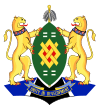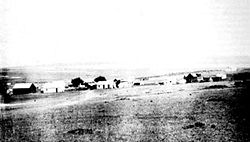Johannesburg
| Johannesburg | |||
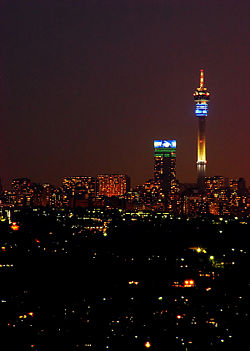 |
|||
|
|||
| Nickname(s): Joburg; Jozi; Egoli (City of Gold); Gauteng Maboneng (City of Lights); Joni; Africa's greatest City | |||
| Motto: Unity in Development | |||
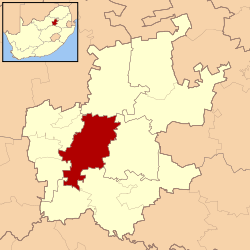 |
|||
 |
|||
| Coordinates: | |||
| Country | South Africa | ||
|---|---|---|---|
| Province | Gauteng | ||
| Established | 1886 | ||
| Government | |||
| - Mayor | Amos Masondo (ANC) [1] | ||
| Area [2] | |||
| - Total | 1,644.96 km² (635.1 sq mi) | ||
| Elevation | 1,753 m (5,751 ft) | ||
| Population (2007)[3] | |||
| - Total | 3,888,180 | ||
| - Density | 2,364/km² (6,122.7/sq mi) | ||
| Time zone | SAST (UTC+2) | ||
| Area code(s) | 011 | ||
| Website: www.joburg.org.za | |||
Johannesburg (pronounced /jō-hān'ĭs-bûrg'/) also known as Joburg, is the largest city in South Africa. Johannesburg is the provincial capital of Gauteng, the wealthiest province in South Africa, having the largest economy of any metropolitan region in Sub-Saharan Africa. The city is one of the 40 largest metropolitan areas in the world[4] and it is one of Africa's only two global cities.[5]. While Johannesburg does not form one of South Africa's three capital cities, it does house the Constitutional Court – South Africa's highest court.
Johannesburg is the source of a large-scale gold and diamond trade, due to its location on the mineral-rich Witwatersrand range of hills. Johannesburg is served by O.R. Tambo International Airport, the largest and busiest airport in Africa and a gateway for international air travel to and from the rest of southern Africa.
According to the 2007 Community Survey, The population of the Greater Johannesburg Metropolitan Area is almost eight million. The population of the municipal city is almost 4 million. Johannesburg's land area of 1,645 square kilometres (635 sq mi) is very large when compared to other cities, resulting in a population density of 2,364 inhabitants per square kilometre (6,123/sq mi). Johannesburg also encompasses Soweto to the south west, a township that the apartheid government established to accommodate the large number of migrant workers. It should be noted that Johannesburg and Pretoria are beginning to act as one functional entity, connecting the province of Gauteng together and forming one Megacity of roughly 10 million people.
Gauteng (as a city) is growing rapidly, due to mass urbanisation that is a feature of many developing countries. According to the State of the Cities Report, the urban portion of Gauteng – comprised primarily of the cities of Johannesburg, Ekurhuleni (the East Rand) and Tshwane (greater Pretoria) – will be a polycentric urban region with a projected population of some 14.6 million people by 2015, making it one of the largest cities in the world.
Contents |
History
The region surrounding Johannesburg was originally inhabited by San tribes Rock paintings. By the 1200s, groups of Nthu people started moving southwards from central Africa and encroached on the indigenous San population. White trekboers started entering the area from the Cape Colony after 1860. Gold was discovered in the 1880s and triggered the gold rush.
Gold was initially discovered some 400 km to the east of present-day Johannesburg, in Barberton. Gold prospectors soon discovered that there were even richer gold reefs in the Witwatersrand. Gold was discovered at Langlaagte, Johannesburg in 1886.
Johannesburg was a dusty settlement some 90km from the Transvaal Republic capital which was Pretoria. The town was much the same as any small prospecting settlement, but, as word spread, people flocked to the area from all other regions of the country, as well as from North America, the United Kingdom and Europe. [6]. As the value of control of the land increased, tensions developed between the Boer government in Pretoria and the British, culminating in the Boer Wars. The Boers lost the wars and control of the area was ceded to the British. Controversy surrounds the origin of the name, as there were any number of people with the name "Johannes" who were involved in the early history of the city. The principal clerk attached to the office of the surveyor-general, Johannes Rissik, Christiaan Johannes Joubert, member of the Volksraad and the Republic's chief of mining, Paul Kruger, President of the Zuid Afrikaansche Republiek (Transvaal). Rissik and Joubert were members of a delegation sent to England to attain mining rights for the area. Joubert had a park in the city named after him and Rissik street is today a main street where the (now dilapidated) Post Office and City Hall are located.
Currently the Johannesburg Metropolitan Council is implementing a large scale Inner City Revival project, leading to some business moving back to the inner city.
Government
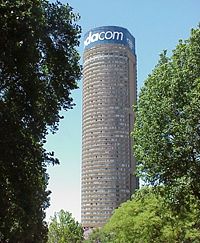
- Main articles: City of Johannesburg Metropolitan Municipality and Regions of Johannesburg
During the apartheid era, Johannesburg was divided into 11 local authorities, seven of which were white and four black or coloured. The white authorities were 90% self-sufficient from property tax and other local taxes, and spent ZAR 600 (USD 93) per person, while the black authorities were only 10% self-sufficient, spending R 100 (USD 15) per person.
The first post-apartheid City Council was created in 1995. The council adopted the slogan "One City, One Taxpayer" in order to highlight its primary goal of addressing unequal tax revenue distribution. To this end, revenue from wealthy, traditionally white areas would help pay for services needed in poorer, black areas. The City Council was divided into four regions, each with a substantially autonomous local regional authority that was to be overseen by a central metropolitan council. Furthermore, the municipal boundaries were expanded to include wealthy satellite towns like Sandton and Randburg, poorer neighbouring townships such as Soweto and Alexandra, and informal settlements like Orange Farm.
In 1999, Johannesburg appointed a city manager in order to reshape the city's ailing financial situation. The manager, together with the Municipal Council, drew up a blueprint called "Igoli 2002". This was a three-year plan that called upon the government to sell non-core assets, restructure certain utilities, and required that all others become self-sufficient. The plan took the city from near insolvency to an operating surplus of R 153 million (USD 23.6 million).
Following the creation of the City of Johannesburg Metropolitan Municipality, Johannesburg was divided into eleven administrative regions (these regions did not correspond to the areas governed by the former local authorities). In 2006, the number of administrative regions was consolidated, from eleven to seven.[7]
Crime
According to the Johannesburg Victim Survey (1993–1997) the crime most afflicting the city's residents between 1993 and 1997 was burglary, with nearly a quarter of the respondents (24%) reporting this crime to the survey. The second most frequently reported incidents were violent crimes: mugging and robbery (16.5%) and assault (15.5%). The vast majority of assaults were of a serious nature, with 84% involving the use of a weapon.[8]
After the Group Areas Act was scrapped in the early 1990s, Johannesburg was affected by urban blight. Thousands of poor, mostly black, people, who had been forbidden to live in the city proper, moved into the city from surrounding black townships like Soweto and many immigrants from economically beleaguered and war torn African nations flooded into South Africa, with Johannesburg the most Northerly major city and therein a logical choice. Crime levels rose, and especially the rate of violent crime. Many buildings were abandoned by landlords, especially in high-density areas, such as Hillbrow. Many corporations and institutions, including the stock exchange, moved their headquarters away from the city centre, to suburbs like Sandton. By the late 1990s, Johannesburg is rated as one of the most dangerous cities in the world.
Reviving the city centre is one of the main aims of the municipal government of Johannesburg. Drastic measures have been taken to reduce crime in the city. These measures include closed-circuit television on street corners. Crime levels in Johannesburg have dropped as the economy has stabilised and begun to grow.[9] In an effort to prepare Johannesburg for the 2010 FIFA World Cup, local government has enlisted the help of former New York mayor Rudolph Giuliani to help bring down the crime rate, as the opening and closing matches of the tournament will be played in the city.[10]
Geography and climate
Johannesburg is located in the eastern plateau area of South Africa known as the Highveld, at an elevation of 1,753 metres (5,751 ft). The former CBD is located on the south side of the prominent ridge called the Witwatersrand (Afrikaans: White Water's Ridge) and the terrain falls to the north and south. By and large the Witwatersrand marks the watershed between the Limpopo and Vaal rivers. The north and west of the city has undulating hills while the eastern parts are flatter.
The city enjoys a dry, sunny climate, with the exception of occasional late afternoon downpours in the summer months of October to April. Temperatures in Johannesburg are usually fairly mild thanks to the city's high altitude, with the average maximum daytime temperature in January of 26 ℃ (79 ℉), dropping to an average maximum of around 16 ℃ (61 ℉) in June. Winter is the sunniest time of the year, with cool days and cold nights. The temperature occasionally drops to below freezing at night, causing frost. Snow is a rare occurrence, with snowfall having been experienced in May 1956, August 1962, June 1964, September 1981 and August 2006 (light). Snow fell again on 27 June 2007,[11] accumulating up to 10 centimeters (3.9 in) in the southern suburbs. Regular cold fronts pass over in winter bringing very cold southerly winds but usually clear skies. The annual average rainfall is 713 millimetres (28.1 in), which is mostly concentrated in the summer months. Infrequent showers occur through the course of the winter months.
Despite the relatively dry climate, Johannesburg has over ten million trees,[12] and it is now the biggest man-made forest in the world, followed by Graskop in Mpumalanga that is the second biggest.[13] Many trees were originally planted in the northern areas of the city at the end of the 19th century, to provide wood for the mining industry. The areas were developed by the Randlord, Hermann Eckstein, a German immigrant, who called the forest estates Sachsenwald. The name was changed to Saxonwold, now the name of a suburb, during World War I. Early (white) residents who moved into the areas (Parkhurst, Parktown, Parkview, Westcliff, Saxonwold, Houghton Estate, Illovo, Hyde Park, Dunkeld, Melrose, Inanda, Sandhurst) now collectively referred to as the Northern Suburbs retained many of the original trees and planted new ones, with the encouragement of successive city councils. In recent years, however, a considerable number of trees have been felled, to make way for the Northern Suburbs' residential and commercial redevelopment.
| Month | Jan | Feb | Mar | Apr | May | Jun | Jul | Aug | Sep | Oct | Nov | Dec | Year |
|---|---|---|---|---|---|---|---|---|---|---|---|---|---|
| Record high °C (°F) | 35 (95) |
34 (93) |
32 (90) |
29 (84) |
26 (79) |
23 (73) |
24 (75) |
26 (79) |
31 (88) |
32 (90) |
33 (91) |
32 (90) |
35 (95) |
| Average high °C (°F) | 26 (79) |
25 (77) |
24 (75) |
21 (70) |
19 (66) |
16 (61) |
17 (63) |
19 (66) |
23 (73) |
24 (75) |
24 (75) |
25 (77) |
22 (72) |
| Average low °C (°F) | 15 (59) |
14 (57) |
13 (55) |
10 (50) |
7 (45) |
4 (39) |
4 (39) |
6 (43) |
9 (48) |
11 (52) |
13 (55) |
14 (57) |
10 (50) |
| Record low °C (°F) | 7 (45) |
6 (43) |
2 (36) |
1 (34) |
-3 (27) |
-8 (18) |
-5 (23) |
-5 (23) |
-3 (27) |
0 (32) |
2 (36) |
4 (39) |
-8 (18) |
| Precipitation mm (inches) | 125 (4.92) |
90 (3.54) |
91 (3.58) |
54 (2.13) |
13 (0.51) |
9 (0.35) |
4 (0.16) |
6 (0.24) |
27 (1.06) |
72 (2.83) |
117 (4.61) |
105 (4.13) |
713 (28.07) |
| Source: South African Weather Service [14] 2007-07-26 | |||||||||||||
Demographics

According to the 2001 South African National Census, the population of Johannesburg is 3,225,812 people, though including the East Rand and other suburban areas it's around 7 million, consisting of people who live in 1,006,930 formal households, of which 86% have a flush or chemical toilet, and 91% have refuse removed by the municipality at least once a week. 81% of households have access to running water, and 80% use electricity as the main source of energy. 22% of Johannesburg residents stay in informal dwellings. 66% of households are headed by one person.
Black Africans account for 73% of the population, followed by whites at 16%, coloureds at 6% and Asians at 4%. 42% of the population is under the age of 24, while 6% of the population is over 60 years of age. 37% of city residents are unemployed. 91% of the unemployed are black. Women comprise 43% of the working population. 19% of economically active adults work in wholesale and retail sectors, 18% in financial, real estate and business services, 17% in community, social and personal services and 12% are in manufacturing. Only 0.7% work in mining.
34% of Johannesburg residents speak Nguni languages at home, 26% speak Sotho languages, 19% speak English, and 8% speak Afrikaans. 29% of adults have graduated from high school. 14% have higher education (University or Technical school). 7% of residents are completely illiterate. 15% have primary education.
34% use public transportation to commute to work or school. 32% walk to work or school. 34% use private transportation to travel to work or school.
53% belong to mainstream Christian churches, 24% are not affiliated with any organized religion, 14% are members of African Independent Churches, 3% are Muslim, 1% are Jewish and 1% are Hindu.
Cityscape
Architecture
Johannesburg is home to some of Africa's tallest structures, such as the Sentech Tower, Hillbrow Tower and the Carlton Centre.
Parks and gardens
Parks and gardens in Johannesburg are maintained by Johannesburg City Parks.[15] They are also responsible for maintaining and planting the millions of trees in Johannesburg.
Johannesburg Botanical Garden, located in the suburb of Emmarentia, is a popular recreational park.
Economy

Johannesburg is the economic and financial hub of South Africa, producing 16% of South Africa's gross domestic product, and accounts for 40% of Gauteng's economic activity.[16] In a 2007 survey conducted by Mastercard, Johannesburg ranked 47 out of 50 top cities in the world as a worldwide centre of commerce (the only city in Africa) ([1]).
Mining was the foundation of the Witwatersrand's economy, but its importance is gradually declining due to dwindling reserves and service and manufacturing industries have become more significant to the city's economy. While gold mining no longer takes place within the city limits, most mining companies still have their headquarters in Johannesburg. The city's manufacturing industries extend across a range of areas and there is still a reliance on heavy industries including steel and cement plants. The service and other industries include banking, IT, real estate, transport, broadcast and print media, private health care, transport and a vibrant leisure and consumer retail market. Johannesburg has Africa's largest stock exchange, the JSE Securities Exchange although it has moved out of the central business district. Due to its commercial role, the city is the seat of the provincial government and the site of a number of government branch offices, as well as consular offices and other institutions.
There is also a significant informal economy consisting of cash-only street traders and vendors. The level of this economic activity is difficult to track in official statistics and it supports a sector of the population including immigrants who are not in formal employment. However, it is clear that the informal economy operating in Johannesburg is certainly one of the biggest in the world.
The Witwatersrand urban complex is a major consumer of water in a dry region. Its continued economic and population growth has depended on schemes to divert water from other regions of South Africa and from the highlands of Lesotho, the biggest of which is the Lesotho Highlands Water Project, but additional sources will be needed early in the 21st century.
The container terminal at City Deep is purported to be the largest "dry port" in the world, with some 60% of cargo that arrives through the port of Durban arriving in Johannesburg. The City Deep area has been declared an IDZ (industrial development zone) by the Gauteng government, as part of the Blue IQ Project.
Retail
Johannesburg's largest shopping centre is Sandton City, while Hyde Park is one of its most prestigious. Other centres include Rosebank, Eastgate, Westgate, Northgate, Southgate, and Cresta. There are also plans to build a large shopping centre, known as the Zonk'Izizwe Shopping Resort, in Midrand. "Zonk'Izizwe" means "All Nations" in Zulu language, indicating that the centre will cater to the city's diverse mix of peoples and races. Also a complex named Greenstone in Modderfontein has been opened and is intended to become the largest shopping complex in the southern hemisphere.
Communications and media

The city is home to several media groups which own a number of newspaper and magazine titles. The two main print media groups are Independent Newspapers and Naspers (Media24). The electronic media is also headquartered in the greater metropolitan region. Beeld is a leading Afrikaans newspaper for the city and the country, while the City Press is a Sunday newspaper that is the third largest selling newspaper in South Africa. The Sowetan is one of a number of titles catering for the black market although in recent years it competes against newly arrived tabloids. The Mail & Guardian is an investigative liberal newspaper while The Citizen is a tabloid-style paper, and The Star is a local newspaper that mostly covers Gauteng-related issues. The Sunday Times is the most widely read national Sunday newspaper. True Love is the most widely read women's magazine, catering primarily to the up and coming middle class black female market, published by Media 24.
Media ownership is relatively complicated with a number of cross shareholdings which have been rationalised in recent years resulting in the movement of some ownership into the hands of black shareholders. This has been accompanied by a growth in black editorship and journalism.
Johannesburg has a number of regional radio stations such as YFM, Metro FM, 702, Highveld Stereo, 5FM, Kaya FM and Classic FM. The number of radio stations has increased in recent years as the government sold off frequencies to private companies. Johannesburg is also the headquarters of state-owned broadcaster South African Broadcasting Corporation and pay broadcast network Multichoice which distributes M-Net and DStv a digital satellite service, while eTV also has a presence in the city. etv is the only other terrestrial broadcaster and it is free-to-air and funded by advertising revenue. The city has two television towers, the Hillbrow Tower and the Sentech Tower.
Music
Kwaito is the musical genre from Johannesburg that is considered to be the post-struggle (post-apartheid) music of choice by South African youth. Some consider Kwaito to be apolitical dance music because the same lyrics are typically repeated throughout the entire song and are placed over the rhythms and beats of House music. However, others argue that Kwaito has an important political message to spread, despite the fact people are able to dance to this music. For example, the artist called Arthur stands up against the established system set during apartheid saying, "Nee baas, don't call me kaffir" in his 1995 song titled "Kaffir". The timing of such a politically charged statement was necessary in the South African society because apartheid had recently been abolished. It is important to note the significance of the words in this phrase. The word "baas" is equivalent to the English word "boss" and was the mandatory title all black employees had to use to address their white employers during apartheid. "Kaffir" is one of the most derogatory and degrading racial names someone can call a black person in South Africa. Because Arthur was commenting on the social relation between black workers and their white bosses and the racial inequality that existed between them, his EP was "an incredibly powerful and provocative statement" that "went straight to the hearts of thousands of South Africans."[17] Kwaito artist Mandoza is another reason why many people argue Kwaito music does have significant political standing in South Africa. One example of Mandoza's political message can be heard with his song "Uzoyithola Kkanjani", which means "how are you going to get it if you don't go for it".
Kwaito has touched more than the music scene in this country. In recent years, it has become deeply embedded in young South African culture because it represents "the streets", street life, and the people who live there. As Grant Clark notes after his trip to Johannesburg, "Kwaito has evolved its own street style. It's not just music, it's the way you walk, talk, dance, and of course, dress." [18] On the other hand, Kwaito does receive its share of criticism from the older generations for embracing what is considered to be Western ideals and beliefs, like materialism and living life in excess. Despite this, there are some older South African musicians who support this musical style. Hugh Masekela is a known fan of Kwaito. When talking about Kwaito, the artist said, "there has been criticism of some of the content of Kwaito music but older people always seem to be jealous of young people who are coming up with new things." [18] Whether Kwaito is criticized for its lack of a political stance or looked down upon by South African elders for straying from their own traditions and values, it definitely has had a impact on the music and culture of post-apartheid society in South Africa.
Suburbs
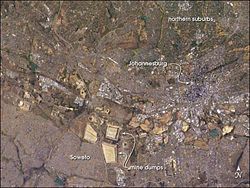
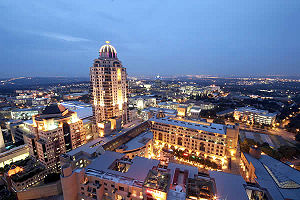
Johannesburg's suburbs are the product of extensive urban sprawl and are regionalised into north, south, east and west, and they generally have different personalities. While the Central Business District and the immediate surrounding areas were formerly desirable living areas, the spatial accommodation of the suburbs has tended to see a flight from the city and immediate surrounds. The inner city buildings have been let out to the lower income groups and illegal immigrants and as a result abandoned buildings and crime have become a feature of inner city life. The immediate city suburbs include Yeoville, a hot spot for black nightlife despite its otherwise poor reputation. The suburbs to the south of the city are mainly blue collar neighbourhoods and situated closer to some townships. The suburbs to the west have in recent years floundered with the decline of the mining industry but have in some cases experienced some revival with properties being bought up by the black middle class. The biggest sprawl lies to the east and north. The eastern suburbs are relatively prosperous and close to various industrial zones. The northern suburbs have been the recipient of most of the flight from the inner city and some residential areas have become commercialised particularly around the area of Sandton, stretching north towards Midrand, a half way point between Johannesburg and the capital Pretoria.
Traditionally the northern and northwestern suburbs have been the centre for the wealthy, containing the high-end retail shops as well as several upper-class residential areas such as Hyde Park, Sandhurst, Northcliff and Houghton, where Nelson Mandela makes his home. The northwestern area in particular is vibrant and lively, with the mostly-black suburb of Sophiatown once centre of political activity and the Bohemian-flavoured Melville featuring restaurants and nightlife. Auckland Park is home to the headquarters of the South African Broadcasting Corporation and the University of Johannesburg.
To the southwest of the City Centre is Soweto, a mostly black urban area constructed during the apartheid regime specifically for housing African people who were then living in areas designated by the government for white settlement. Today, Soweto is among the poorest parts of Johannesburg.
Tourism
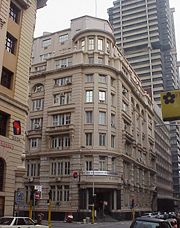
Johannesburg has not traditionally been known as a tourist destination, but the city is a transit point for connecting flights to Cape Town, Durban, and the Kruger National Park. Consequently, most international visitors to South Africa pass through Johannesburg at least once, which has led to the development of more attractions for tourists. Recent additions have centred around history museums, such as the Apartheid Museum and the Hector Pieterson Museum. Gold Reef City, a large amusement park to the south of the Central Business District, is also a large draw for tourists in the city. The Johannesburg Zoo is also one of the largest in South Africa.
The city also has several art museums, such as the Johannesburg Art Gallery, which featured South African and European landscape and figurative paintings. The Museum Africa covers the history of the city of Johannesburg, as well as housing a large collection of rock art. The Market Theatre complex attained notoriety in the 1970s and 1980s by staging anti-apartheid plays, and has now become a centre for modern South African playwriting.
There is also a large industry around visiting former townships, such as Soweto and Alexandra. Most visitors to Soweto go to see the Mandela Museum, which is located in the former home of Nelson Mandela.
The Cradle of Humankind UNESCO World Heritage Site is 25 kilometers (16 mi) to the northwest of the city. The Sterkfontein fossil site is famous for being the world's richest hominid site and produced the first adult Australopithecus africanus and the first near-complete skeleton of an early Australopithecine.
Sports teams and stadiums
| Club | Sport | League | Stadium |
|---|---|---|---|
| Kaizer Chiefs | Football | Premier Soccer League | Johannesburg Stadium |
| Moroka Swallows | Football | Premier Soccer League | Rand Stadium |
| Orlando Pirates | Football | Premier Soccer League | FNB Stadium |
| Alexander United | Football | MTN Supersport Leagues | Alexander Stadium |
| Katlehong City | Football | MTN Supersport Leagues | Potgietersrus Rugby Stadium |
| Highveld Lions | Cricket | Standard Bank Cup Series | Wanderers Stadium |
| Lions | Rugby union | Super 14 | Ellis Park Stadium |
| Golden Lions | Rugby union | Currie Cup | Ellis Park Stadium |
Johannesburg's most popular sports by participation are association football, cricket, rugby union, and running. The Lions, formerly the Cats, represent Johannesburg, North West and Mpumalanga in the Southern Hemisphere's Super 14 Rugby Competition, which includes teams from South Africa, Australia, and New Zealand.
Cricket is one of the more popular sports. In cricket, the Highveld Lions represent Johannesburg, the rest of Gauteng as well as the North West Province at the Wanderers Stadium which was the venue for the 2003 Cricket World Cup Final in which Australia successfully defended their title. Wanderers Stadium hosted what many cricket fans consider the greatest ever ODI match in which South Africa successfully chased down 434 runs. They take part in the first class SuperSport Series, the one-day MTN Domestic Championship and the Twenty20 Standard Bank Pro 20 Series.
Johannesburg also hosted matches from and the final of the ICC World Twenty20. in which India beat Pakistan in the final.
Early each Sunday morning, tens of thousands of runners gather to take part in informal runs organised by several athletic clubs. People from Johannesburg are football mad and clubs from Johannesburg either play in the Premier Soccer League (PSL) or the First Division. In the PSL, the top Johannesburg teams are all fierce rivals and include Kaizer Chiefs (also known as the Amakhosi), Orlando Pirates (also known as the Buccaneers) and Moroka Swallows, based at the city's Johannesburg, Rand, and FNB stadiums respectively. Witwatersrand University, nicknamed the Clever Boys, who have a player membership of over 1,500, one of the world's largest are also part of the premier league. First Division teams include Katlehong City and Alexander United, who play at Alexander and Reiger Park stadiums respectively
Transport
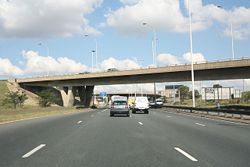
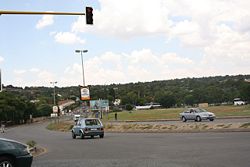

Johannesburg, much like Los Angeles, is a young and sprawling city geared towards private motorists, and lacks a convenient public transportation system. A significant number of the city's residents are dependent on the city's informal minibus taxis.
Airports
Johannesburg is served by OR Tambo International Airport (formerly Johannesburg International Airport) for both domestic and international flights. Other airports include Rand Airport, Grand Central Airport, and Lanseria. Rand Airport, located in Germiston, is a small airfield used mostly for private aircraft and the home of South African Airways's first Boeing 747 Classic, the Lebombo, which is now an aviation museum. Grand Central is located in Midrand and also caters to small, private aircraft. Lanseria Airport is used for commercial flights to Cape Town, Durban, Port Elizabeth, Botswana, and Sun City.
Freeways
The fact that Johannesburg is not built near a large navigable body of water has meant that from the very beginning of the city's history, ground transportation has been the most important method of transporting people and goods in and out of the city. One of Africa's most famous "beltways" or ring roads/orbitals is the Johannesburg Ring Road. The road is composed of three freeways that converge on the city, forming an 80 kilometers (50 mi) loop around it: the N3 Eastern Bypass, which links Johannesburg with Durban; the N1 Western Bypass, which links Johannesburg with Pretoria and Cape Town; and the N12 Southern Bypass, which links Johannesburg with Witbank and Kimberley. The N3 was built exclusively with asphalt, while the N12 and N1 sections were made with concrete, hence the nickname given to the N1 Western Bypass, "The Concrete Highway". In spite of being up to 12 lanes wide in some areas (6 lanes in either direction), the Johannesburg Ring Road is frequently clogged with traffic. The Gillooly's Interchange, built on an old farm and the point at which the N3 Eastern Bypass and the R24 Airport Freeway intersect, is purported to be the busiest interchange in the Southern Hemisphere. It is also claimed that the N1 is the busiest road in South Africa.
Taxis
Johannesburg has two kinds of taxis, metered taxis and minibus taxis. Unlike many cities, metered taxis are not allowed to drive around the city looking for passengers and instead must be called and ordered to a destination. The Gauteng Provincial Government has launched a new metered taxi programme in an attempt to increase use of metered taxis in the city.
The minibus "taxis" are the de facto standard and essential form of transport for the majority of the population. Since the 1980s The minibus taxi industry has been severely affected by turf wars.
Although essential, these taxis are often of a poor standard in not only road-worthiness, but also in terms of driver quality with a majority of taxi drivers breaking traffic laws regularly (such as driving in the emergency lane while speeding on a highway). With the high demand for transport by the working class of South Africa, minibus taxis are often over-filled with passengers causing yet another hazard for road users. However, without subsidies from Government and a lack of other feasible public transport, minibus taxis will remain an essential form of transport for many of Joburg's working class.
Mass transit
Johannesburg's metro railway system connects central Johannesburg to Soweto, Pretoria, and most of the satellite towns along the Witwatersrand. The railways transport huge numbers of workers everyday. However, the railway infrastructure was built in Johannesburg's infancy and covers only the older areas in the city's south. The northern areas, including the business districts of Sandton, Midrand, Randburg, and Rosebank, currently lack rail infrastructure.
Trains
Construction of the Gautrain Rapid Rail started in October 2006 and will be completed by 2011, not in time for the FIFA World Cup. It will consist of a number of underground stations, as well as above ground stations. It will run from Johannesburg's Park Station, through Rosebank, Sandton, Midrand and into Pretoria. There will also be a line from the OR Tambo International Airport traveling to Sandton. This will be the first new railway system that has been laid in South Africa since 1977. The Gauteng Provincial Government's Blue IQ Project, Gautrain, however, has made provisions for the creation of a rapid rail link, running north to south, between Johannesburg and Pretoria, and east-west between Sandton and Johannesburg International Airport. Slated to be ready in time for the 2010 FIFA World Cup, the rail system is being designed to alleviate traffic on the N1 freeway between Johannesburg and Pretoria, which records vehicle loads of up to 300,000 per day.
Buses
Johannesburg is served by a bus fleet operated by Metrobus, a corporate unit of the City of Johannesburg. It has a fleet consisting of approximately 550 single and double-decker buses, plying 84 different routes in the city. This total includes 200 modern buses (150 double-deckers and 50 single-deckers), made by Volvo and Marcopolo/Brasa in 2002. Metrobus' fleet carries approximately 20 million passengers per annum. In addition there are a number of private bus operators, though most focus on the inter-city routes, or on bus charters for touring groups. The City's main bus terminus is situated in Gandhi Square, where passengers can also obtain information regarding the Metrobus service from the walk-in customer information desk.
PUTCO also operated buss routes in and around the city.
Bus Rapid Transit
The City of Johannesburg has begun construction on its new Bus Rapid Transit (BRT) system. The BRT project, titled Rea Vaya (We are moving), aims to rid the city's roads of congestion and promote safe, efficient and reliable public transport. It will run seven days a week, from 05h00 until midnight. Bus frequencies will be between two and five minutes during peak hours, and seven and ten minutes during the off-peak. The system will operate on main roads throughout the city, running down designated median lanes. Rea Vaya will also offer additional, smaller feeder-buses to areas around each BRT station to ensure speedy connections from homes to main routes. The BRT stations will be located every 500m along each BRT route, offering ticket vending machines and live travel information. Larger BRT stations will also offer sales kiosks, bathrooms and park and ride facilities. The BRT system has been designed with other transport modes in mind, so as to ensure a smooth change from various transportation options - particularly with the Gautrain. The first phase of the BRT is intended to be up and running in time for the 2010 FIFA World Cup.
Universities in Johannesburg
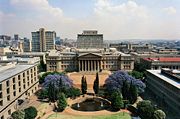
Johannesburg has a well-developed higher education system of both private and public universities. Johannesburg is served by the public universities University of the Witwatersrand and the University of Johannesburg.
University of Johannesburg was formed on 1 January 2005 when three separate universities and campuses—Rand Afrikaans University, Technikon Witwatersrand, and the Johannesburg campuses of Vista University—were merged. The new university offers education primarily in English and Afrikaans, although courses may be taken in any of South Africa's official languages.
The University of the Witwatersrand is one of the leading universities in South Africa, and is famous as a centre of resistance to apartheid, earning it the nickname "Moscow on the Hill".
Private universities include Monash University, which has one of its eight campuses in Johannesburg (six of the other campuses are in Australia, while the eighth is in Malaysia), and Midrand Graduate Institute which is located in Midrand.
Sister cities
Johannesburg's sister cities are:
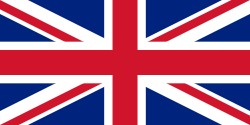 Birmingham, United Kingdom [19]
Birmingham, United Kingdom [19]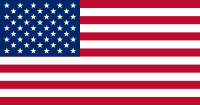 New York City, New York (United States)[20]
New York City, New York (United States)[20]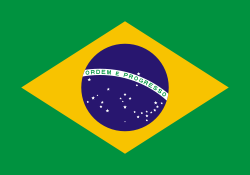 São Paulo, Brazil.
São Paulo, Brazil. Xi'an, China.
Xi'an, China.
References
- Early Johannesburg, Its Buildings and People. Hannes Meiring, Human & Rousseau. 1986. 143 pages. ISBN 0-7981-1456-8
- Gold! Gold! Gold! The Johannesburg Gold Rush. Eric Rosenthal, AD. Donker, 1970, ISBN 0-949937-64-9
- Johannesburg: The Elusive Metropolis. Sarah Nuttall. Duke University Press. 9 January 2005. 210 pages. ISBN 0-8223-6610-X.
- The Corner House: The Early History of Johannesburg. Alan Patrick Cartwright. MacDonald. 1965. 293 pages.
- ↑ "City of Johannesburg Metropolitan Municipality". Gauteng Department of Local Government. Retrieved on 2008-09-29.
- ↑ Municipal Demarcation Board, South Africa Retrieved on 2008-03-23.
- ↑ Statistics South Africa, Community Survey, 2007, Basic Results Municipalities (pdf-file) Retrieved on 2008-03-23.
- ↑ Principal Agglomerations of the World
- ↑ GaWC Research Bulletin 5, GaWC, Loughborough University, 28 July 1999
- ↑ van Onselen, Charles. New Nineveh and New Babylon.
- ↑ Jozi plans major restructuring by Anish Abraham, Official website of the City of Johannesburg, 2006-05-11.
- ↑ Victims of Crime in Johannesburg by Antoinette Louw, Mark Shaw, Lala Camerer, Rory Robertshaw, Published in Monograph No 18, Crime in Johannesburg, February 1998.
- ↑ Drop in serious crime in Jo'burg, Mail & Guardian Online, 2006-07-07.
- ↑ Press Release 6 August 2006, City of Johannesburg is calling for Internal Branding Advice from Global Gurus.
- ↑ SABCnews.com. "Joburg covered by snow as temperature drops". Retrieved on 2007-07-16.
- ↑ Jozi's urban forest now at 10 m trees, and growing by Lucille Davie, 2004-09-08.
- ↑ Joburg advertises its successes by Ndaba Dlamini, 2006-02-15.
- ↑ "Climate data for Johannesburg" (in English). Retrieved on 26 July, 2007.
- ↑ "Custodians of Joburg's green heritage". Johannesburg City Parks. Retrieved on 2008-09-29.
- ↑ "Johannesburg". 2010 Communication Project Management Unit. Government Communication and Information System (GCIS). Retrieved on 2008-09-29.
- ↑ Steingo, Gavin. "South African music after Apartheid: kwaito, the "party politic", and the appropriation of gold as a sign of success." In Popular Music and Society. July 2005. http://findarticles.com/p/articles/mi_m2822/is_3_28/ai_n15648564/pg_4
- ↑ 18.0 18.1 Clark, Grant. "Kwaito: The Voice of Youth." From BBC World Service "Rhythms of the Continent: South Africa". http://www.bbc.co.uk/worldservice/africa/features/rhythms/southafrica.shtml
- ↑ "Partner Cities". Birmingham City Council. Retrieved on 2008-09-30.
- ↑ "Online Directory: South Africa, Africa". Sister Cities International. Retrieved on 2008-09-30.
See also
- Large Cities Climate Leadership Group
External links
Government
News
Other
- Business in Johannesburg
- Economist.com City Guide
- Gauteng Tourism Authority
- Happenings and Tourist Info
- Johannesburg Guide
- Johannesburg on Birmingham's Partner City page
- Johannesburg on Google Maps
- Johannesburg Tourism official website
- Johannesburg travel guide from Wikitravel
- Official Web Portal of South Africa
- Pictures of Johannesburg post-apartheid
- VisitSouthAfrica.net
|
||||||||
 |
Province of Gauteng |
|
|---|---|---|
| Provincial Capital: |
Johannesburg |
|
| Metropolitan Municipalities: |
City of Johannesburg, City of Tshwane, Ekurhuleni |
|
| District Municipalities: |
Sedibeng , West Rand, Metsweding |
|
| Cities: |
Johannesburg, Pretoria |
|
| Smaller Cities: |
Benoni, Boksburg, Vereeniging |
|
|||||
|
|||||
|
||||||||||

